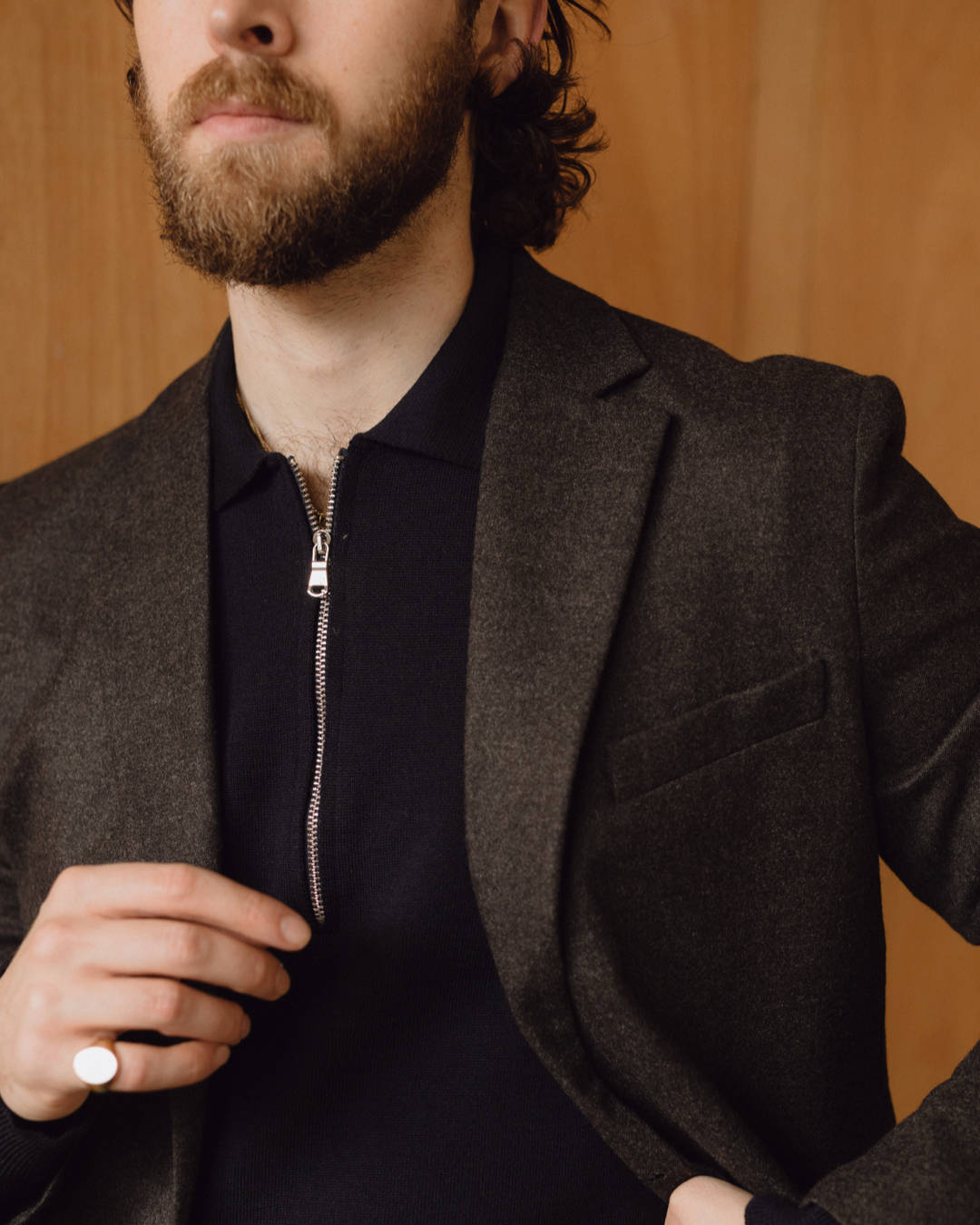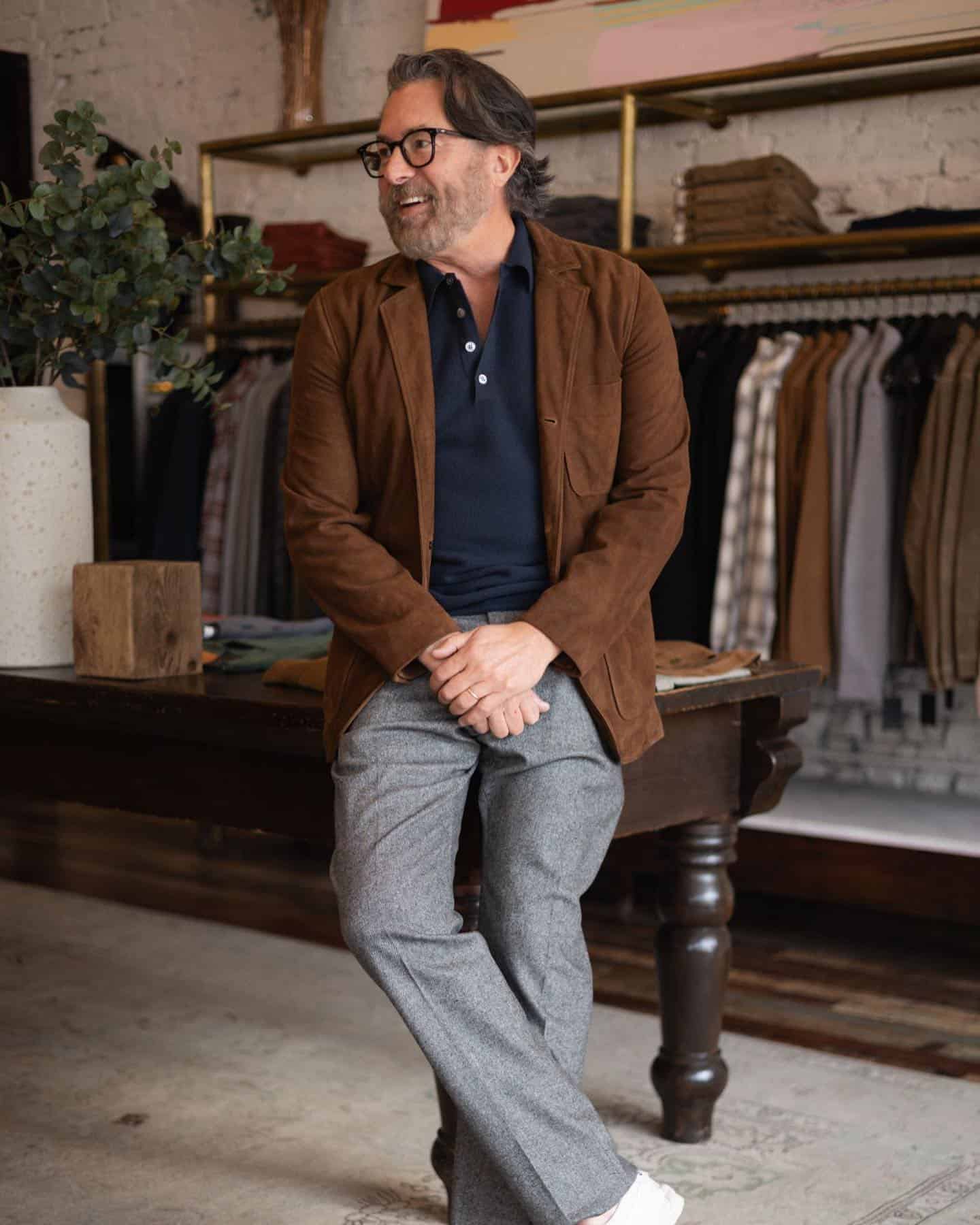Dark Academia fashion, a unique intersection of men’s dark academia style and the broader dark academia aesthetic, marries classical literature and academic inspiration with timeless wardrobe choices.
This style, known for its muted color schemes and vintage-inspired pieces, reflects a deep appreciation for intellectualism and the arts. It stands as a compelling expression of both personal and stylistic identity, appealing to those drawn to the elegance and romanticism of scholarly pursuits.
In this article, we explore all that dark academia fashion has to offer, from its evolution and history to how to wear it today.

What Is Dark Academia Fashion?
Emerging in the late 2010s, Dark Academia fashion transcends clothing to embody a lifestyle that cherishes intellectualism and the arts, setting it apart from similar dark-themed aesthetics like goth through its focus on academia rather than rebellion.
Its adaptability allows for a seamless blend of historical influences with contemporary fashion, making it a versatile and enduring choice for those drawn to the elegance and romanticism of scholarly pursuits.

The Evolution of Dark Academia Fashion
The evolution of Dark Academia fashion is a captivating narrative of adaptation and enrichment, reflecting the changing landscapes of culture, society, and fashion. This aesthetic, rooted in the intellectual and literary, has grown to encompass a broader spectrum of influences, deepening its allure and complexity.
Scholarly Beginnings and the Embrace of the Past
Dark Academia’s inception is deeply tied to the reverence for academia and the arts, with fashion choices mirroring the intellectual pursuits of their wearers. The early 20th century laid the groundwork, emphasizing garments like tweed blazers, wool trousers, and leather accessories that symbolized a dedication to scholarly endeavors.
This period highlighted an affinity for the past, drawing inspiration from historical figures and eras renowned for their contributions to literature, philosophy, and the arts.
The Post-War Era: Intellectuals and the European Influence
Following World War II, there was a noticeable shift in Dark Academia fashion, influenced by the intellectual circles of Europe. The style became more defined, incorporating elements from French and British intellectuals who favored a mix of utility and elegance.
This era saw the integration of berets, scarves, and tailored coats, pieces that offered a nod to European literary and philosophical traditions while maintaining the aesthetic’s academic roots.
The Digital Renaissance: A Global Community of Enthusiasts
The advent of the internet and the rise of social media platforms marked a significant turning point for Dark Academia fashion. Online communities formed, dedicated to exploring and expanding the aesthetic beyond its traditional boundaries.
This digital renaissance allowed for a global exchange of ideas, blending historical influences with contemporary fashion trends. It introduced a wider range of materials, patterns, and silhouettes, adapting the style to various climates and cultures while retaining its core identity.
Dark Academia Aesthetic Fusion: Types of Dark Academia Fashion
As Dark Academia continues to evolve, it has absorbed elements from various other aesthetics, including but not limited to, romanticism, gothic, and even elements of punk for a more rebellious edge.
This fusion has enriched the aesthetic, offering a more inclusive and diverse interpretation of what constitutes “academic” or “scholarly” fashion.
The incorporation of softer, romantic elements, like lace and ruffles, alongside the more traditional structured pieces, speaks to the aesthetic’s flexibility and its ability to adapt to the personal style of its adherents.

Key Components of Dark Academia Fashion for Men
Dark Academia fashion, with its rich tapestry of history and literature, is composed of key garments and accessories that are as much about their aesthetic appeal as they are about their historical significance. Each piece tells a story, reflecting the periods and personalities that have shaped them into icons of this intellectual style.
Tailored Blazers and Tweed Jackets: The Quintessence of Academia
The tailored blazer and tweed jacket are synonymous with the academic elite, tracing their origins back to the universities of the 19th century. These pieces were popularized by scholars and professors who favored them for their blend of formality and comfort.
The tweed jacket, in particular, owes much of its association with academia to the British Isles, where it was adopted by the intellectual and literary circles as a symbol of refined country elegance.
These garments became staples of the Dark Academia aesthetic, embodying the scholarly pursuit of knowledge and the romanticism of academic life.
Oxford Shirts and Knitwear: Layering Intellectualism
Oxford shirts have a storied history within university attire, named after the Oxford cloth from which they were originally made. These shirts became a staple of collegiate wardrobes for their durability and comfort, easily transitioning from classroom to casual social settings.
Similarly, knitwear such as wool sweaters and vests were essential for their practicality in the often-dreary climates of prestigious universities, offering warmth while maintaining an air of scholarly decorum.
These items were popularized by students and academics alike, who layered them for both necessity and style, seamlessly blending functionality with academic elegance.
Wool Trousers and Corduroy Pants: The Scholar’s Choice
The preference for wool trousers and corduroy pants in Dark Academia fashion is rooted in their historical use in academic and intellectual circles. Wool trousers, with their origins in formal menswear, were adapted by students for their practicality and comfort during long hours of study and debate.
Corduroy, known for its durability and warmth, became associated with professors and intellectuals who often wore them as part of their daily attire. These fabrics were chosen not only for their functional benefits but also for their aesthetic qualities, aligning with the Dark Academia ethos of blending the practical with the poetic.
Leather Accessories: Craftsmanship and Legacy
Leather goods such as satchels, belts, and shoes hold a special place in Dark Academia fashion for their blend of craftsmanship and legacy. The leather satchel, a staple of academic attire, traces its origins to the bags carried by scholars and messengers throughout history, embodying the journey of knowledge.
Leather belts and shoes, chosen for their quality and durability, complement the aesthetic’s emphasis on items that age well and carry a sense of history. These accessories reflect the Dark Academia value of investing in pieces that are not only functional but also carry a narrative of their own.

Dark Academia Hairstyles & Grooming
The Dark Academia aesthetic extends beyond clothing to hairstyles and grooming, reflecting an admiration for the polished yet understated elegance of historical and literary figures.
Dark Academia Hairstyles for Men
The hairstyles associated with the dark academia aesthetic are timeless, evoking the appearance of scholars, poets, and intellectuals from the late 19th and early 20th centuries.
Side Part: The side part is a quintessential hairstyle within Dark Academia fashion, favored for its versatility and classic appeal. Historically, this style was popularized by gentlemen of the early 20th century, embodying the era’s polished aesthetic.
It was adopted by academics and intellectuals for its neat appearance, which conveyed a sense of order and seriousness suitable for scholarly pursuits. The side part has been immortalized by literary figures and movie characters alike, representing a bridge between the academic world and the arts.
Textured Waves: Textured waves draw inspiration from the Romantic period, reflecting the aesthetic’s penchant for blending historical influences. This style pays homage to the poets and artists of the 19th century who often wore their hair longer and with natural waves, embodying a rebellion against the strictures of earlier times.
The look conveys a sense of artistic flair and intellectual depth, qualities that are central to the Dark Academia ethos. It’s a style that balances between meticulous grooming and a touch of the untamed, mirroring the aesthetic’s celebration of both the disciplined and the creative spirit.
Dark Academia Facial Hair: The Philosophers’ Influence
Facial hair in Dark Academia fashion is inspired by the philosophers and thinkers of the past, many of whom were distinguished by their beards and mustaches. These elements of grooming were seen as symbols of wisdom and maturity, characteristics revered within academic circles.
The style ranges from the neatly trimmed mustache, evoking the precision of the Victorian era, to the fuller beard, reminiscent of the rugged intellectualism of the early 20th century. The key is in the grooming, reflecting a balance between the cultivated and the natural, much like the aesthetic itself.

Men’s Dark Academia Style Icons: The Embodiment of the Aesthetic
Dark Academia fashion draws inspiration from a diverse array of historical and fictional icons, each contributing to the rich tapestry of the style.
Oscar Wilde: The Dandy Intellectual
Oscar Wilde, with his flamboyant yet thoughtful approach to fashion, stands as a pinnacle of Dark Academia style. Known for his sharp wit and literary genius, Wilde made fashion choices that mirrored his love for beauty and art.
His preference for velvet jackets, intricately tied cravats, and an overall air of sophisticated nonchalance has made him a lasting icon of the aesthetic. Wilde embodies the Dark Academia principle that one’s attire can be both an expression of intellectualism and a work of art.
T.S. Eliot: The Conservative Modernist
T.S. Eliot’s understated style reflects the more conservative side of Dark Academia fashion. As a towering figure in modernist poetry, Eliot had a personal style that was characterized by traditional suits, often paired with a waistcoat and a discreetly patterned tie.
His look represents the academic’s uniform, blending seamlessly into the background of university halls and libraries, yet distinguished by its craftsmanship and attention to detail.
Sherlock Holmes: The Quintessential Detective
Sherlock Holmes, the iconic detective created by Sir Arthur Conan Doyle, stands as a quintessential figure within the Dark Academia aesthetic, seamlessly embodying the blend of intellect, mystery, and distinctive style that defines the movement.
Characterized by his sharp deductive skills and complex persona, Holmes had a fashion—encompassing the famed tweed deerstalker hat, Inverness cape, and meticulously tailored Victorian suits—mirrors his analytical and methodical approach to solving mysteries.
Although the deerstalker hat and Inverness cape have become symbols of his investigative prowess, his overall attire reflects a Victorian and Edwardian elegance, merging functionality with an academic flair.
Holmes not only represents the intellectual and adventurous spirit of Dark Academia but also serves as an inspiration for those drawn to the aesthetic’s core values of knowledge, analysis, and a Gothic sensibility, making him an enduring icon of scholarly style.

Dark Academia Outfits: How to Wear the Dark Academia Aesthetic Today
In today’s fashion landscape, embracing Dark Academia outfits means skillfully blending traditional elements with modern sensibilities. This involves pairing classic pieces like tweed blazers with contemporary slim-fit trousers, allowing for a harmonious bridge between past and present.
Layering plays a crucial role, with oxford shirts and knitwear serving as versatile bases that can be adapted to various climates and occasions. The use of sustainable and ethically sourced materials reflects the aesthetic’s evolving values, ensuring that style choices are not only visually appealing but also socially responsible.
Accessories, from leather satchels to vintage watches, are key in adding personal touches that underscore the look’s academic roots. Brogues or leather boots round out the ensemble, combining functionality with an homage to quality and heritage with your dark academia outfits.
FAQ
-
-
The Dark Academia aesthetic is a style and philosophy that emphasizes a passion for knowledge, literature, and classical elements, combined with a Gothic and academic-inspired visual. It celebrates scholarly pursuits, the beauty of reading and learning, and incorporates fashion, decor, and lifestyle elements reminiscent of ancient libraries, universities, and an overall appreciation for the arts and intellectualism.
-
Dark Academia fashion has roots that trace back to various historical periods, but as a named and cohesive aesthetic, it gained prominence and a defined identity on social media platforms in the late 2010s, particularly around 2018-2019.
-
The core rules for Dark Academia include an emphasis on classic literature, academic achievement, and an appreciation for the arts and history. Fashion-wise, it leans towards vintage-inspired, scholarly attire such as tweed blazers, wool trousers, and leather satchels, favoring a muted, earthy color palette and layering of textures and fabrics.
-
While both goth and Dark Academia aesthetics share an affinity for dark themes and a certain overlap in color palettes, goth is more focused on the macabre, rebellion, and punk culture, often with a heavier use of black and more emphasis on alternative music scenes. Dark Academia, on the other hand, gravitates towards academic and classical influences, celebrating literature, history, and a more traditional, scholarly appearance.
-
The Dark Academia aesthetic predominantly features a palette of muted, earthy tones such as dark browns, blacks, deep greens, and burgundy, complemented by softer hues like beige, ivory, and grey. This color scheme reflects the aesthetic’s inspiration from classical architecture, vintage libraries, and academic institutions, creating a subdued yet rich visual identity.
-
Read the original article here



